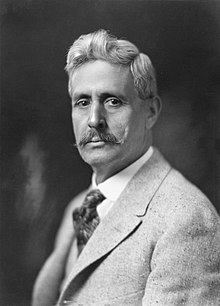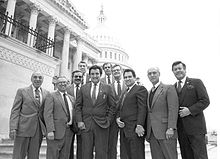
Hispanic and Latino Americans have served in the United States Congress since the early 19th century. The first group elected to serve in the Congress were incorporated as part of the United States territorial expansion into previous Spanish territories of the North American mainland as part of American campaigns of manifest destiny. [1] The earliest Hispanic and Latino Representation in Congress came in the form of territorial delegates from newly acquired territories, such as Florida, New Mexico, and more, serving as representatives for territories that later on join the United States with full statehood. [2] The history of Latino and Hispanic Americans in Congress is intertwined with the history of United States expansion on the North American mainland, with expansion into previous Spanish and Mexican lands leading to expansions in Hispanic and Latino influence in Congress. [3]
Contents
- History of representation
- Manifest Destiny and 19th century expansion
- Post Spanish-American War period
- The modern era
- Post World War II representation
- 21st century
- List of Hispanic and Latino Americans in the United States Congress
- United States Congress
- See also
- References
- External links

The early periods of Hispanic and Latino representation in Congress struggled from inabilities to gain legislative traction as positions as territorial delegates were often met with skepticism from other members of Congress as they were categorized as outsiders. [1] Important legislative steps forward in the 20th century coupled with expanding Hispanic and Latino influence grew the legislative and political presence of Hispanic and Latino Americans in Congress.
Parallels and dissimilarities have been drawn between the experiences of Latino and Hispanic Americans in Congress and those of African Americans in the United States Congress. Among the notable similarities are that the history of both of these groups in Congress have been largely served in the House of Representatives, with Hispanic and Latino Americans not elected to the Senate until Octaviano Ambrosio Larrazolo was elected in 1928, as both Dominique Bouligny and Judah P. Benjamin of Louisiana were appointed. [1] Additionally, like African American representatives in Congress, Hispanic and Latino Americans have taken on the role of surrogates for their ethnic communities, expanding their representation beyond the scope of districts and states to try to begin to provide substantive representation to Hispanic and Latino Americans. [4] [5] [1] One major difference faced by Hispanic and Latino Congress members was the saliency and discussion surrounding race, as many of the early representatives faced lower levels of criticism and scrutiny than early African American politicians. [1]
A total of 164 Hispanic or Latino Americans have served in the United States Congress, a majority of which have served in the United States House of Representatives. Of the 150 total, 36 have served as non-voting members of the House of Representatives as either Territorial Delegates or Resident Commissioners of Puerto Rico.
150 Hispanic and Latino Americans have served as U.S. representatives in the United States House of Representatives, meaning that 150 of the total 164 Hispanic and Latino Americans to serve in Congress, or 95%, have served in the House of Representatives at one point; 5 members of the House of Representatives have gone on to serve in the Senate, the most recent of which is Senator Ben Ray Luján of New Mexico who served in both houses of Congress. [3]
A total of 14 Hispanic and Latino Americans have served in the United States Senate, with 6 serving from the Republican party and 8 from the Democratic Party. A total of 5 Hispanic or Latino Americans served in the United States Senate before the 21st century, three serving as senators for the state of New Mexico and 2 from the state of Louisiana. [6] The 9 senators remaining served during the 21st century: 5 Democrats, from California, Colorado, New Jersey, New Mexico and Nevada respectively; and 4 Republicans, 2 from Florida, 1 from New Hampshire and 1 from Texas.












